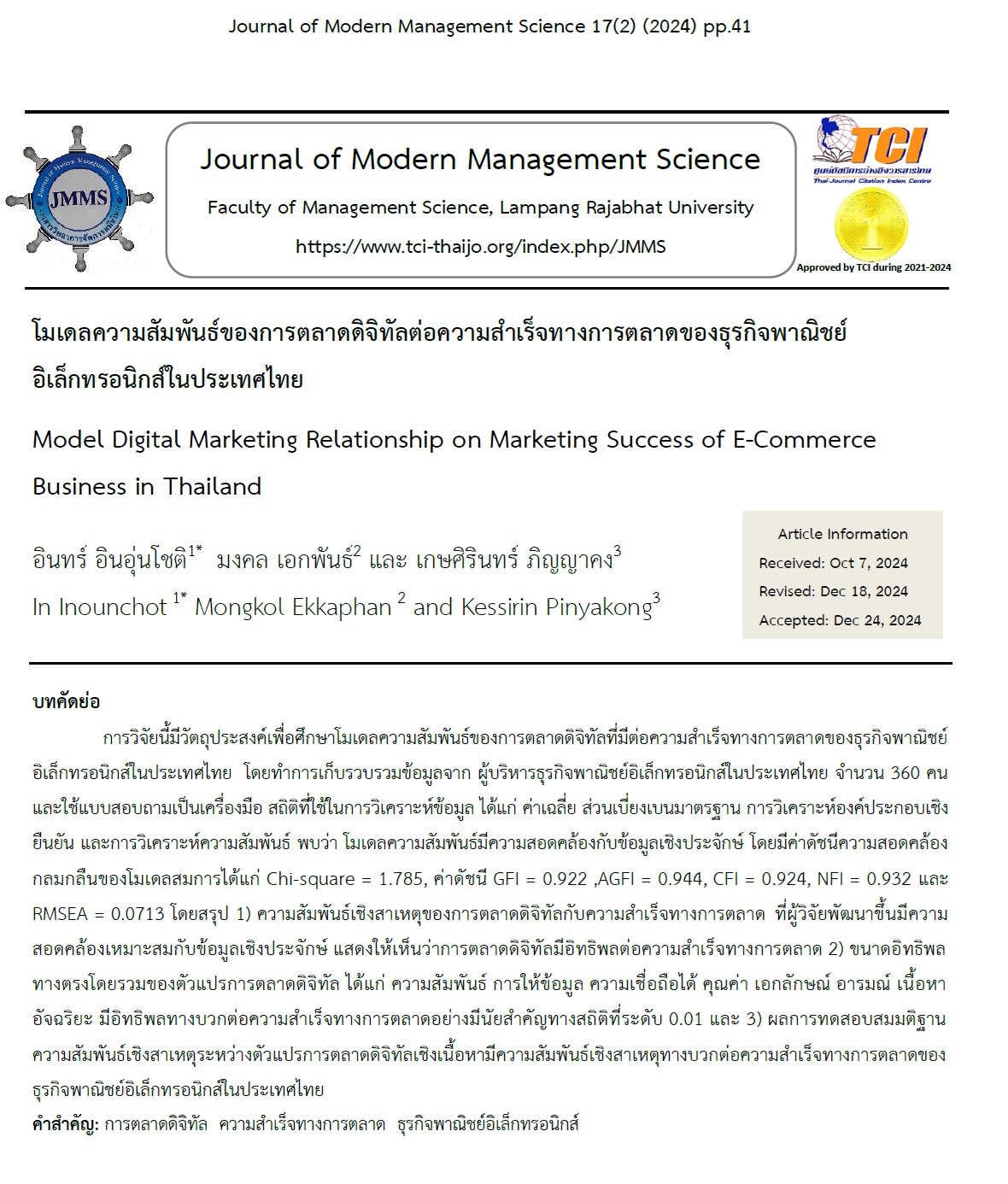Model Digital Marketing Relationship on Marketing Success of E-Commerce Business in Thailand
Main Article Content
Abstract
The purposes of research were to examine the causal relationship model between the digital marketing on marketing success of E-Commerce Business in Thailand. The sample were 360 E-Commerce Business executives around Thailand that collected by questionnaire. Statistics were mean, standard deviation, factor analysis, correlation and path analysis were used to find out causal relationship with structural equation model (SEM). In addition, it was also found that the developed model conformed with the empirical data. Their goodness of fit indexes showed that Chi-square = 1.785, ค่าดัชนี GFI = 0.922, AGFI = 0.944, CFI = 0.924, NFI = 0.932 และ RMSEA = 0.0713 1) The structural equation modelling of digital marketing on marketing success in this study indicates an excellent fit between the model and observed data. This shows that all factors comprising of the digital marketing have impact on marketing success of E-Commerce Business in Thailand. 2) The direct total effects of factors on digital marketing all factors comprising of the relationship, information, reliability, value, identity, emotion and intelligent content have positive impact on marketing success of E-Commerce Business in Thailand at the significant level of 0.01. 3) All hypotheses are accepted. This also shows that all factors comprising of the digital marketing have positive impact on marketing success of E-Commerce Business in Thailand.
Article Details

This work is licensed under a Creative Commons Attribution-NonCommercial-NoDerivatives 4.0 International License.
The article must be considered and accepted for publication by the editorial board of the Faculty of Management Science, Lampang Rajabhat University. The articles have been reviewed by a peer (peer review) and the author must update according to the suggestion if available before publication. Articles that are not considered the editorial team will inform the results of the consideration but will not send the original to the author.
JMMS is the Faculty of Management Science journal, Lampang Rajabhat University. Jmms published both print and online editions. We allow the use of articles for academic use under the scope of copyright law.
References
กรมพัฒนาธุรกิจการค้า. (2565). ข้อมูลทั่วไปผู้ประกอบการธุรกิจค้าปลีกในประเทศไทย. สืบค้นเมื่อวันที่ 20 กันยายน 2566, สืบค้นจาก https://www.dbd.go.th/
กุณฑลี รื่นรมย์. (2561). การกำหนดปัญหางานวิจัยด้านการตลาดดิจิทัลสำหรับประเทศไทยในอนาคต. จุฬาลงกรณ์ธุรกิจปริทัศน์, 40(157), 123-138.
นัทวี ตันติสาธรรม. (2564). ดิจิทัลมาร์เก็ตติ้งสำหรับยุคนั้นคือการเปลี่ยนเครื่องมือสื่อสาร จากเครื่องมือเก่าไปสู่เครื่องมือใหม่. กรุงเทพฯ: มหาวิทยาลัยเกษตรศาสตร์.
บุญชม ศรีสะอาด. (2558). การวิจัยเบื้องต้น. พิมพ์ครั้งที่ 7. กรุงเทพฯ : สุวีริยาสาส์น.
พลูศรี เจริญ. (2565). แนวโน้มระยะยาวของกลุ่มธุรกิจเทคโนโลยี 5G. อ้างอิงมาจาก NIA : National Innovation Agency, Thailand.
ศูนย์วิจัยกสิกรไทย. (2565). เศรษฐกิจไทยไตรมาส 2/2563 คาดหดตัวลุกสุดในปีนี้ แต่ครึ่งปีหลังยังคงมีความเสี่ยงสูงและยังต้องติดตามมาตรการเพิ่มเติม (มองเศรษฐกิจ ฉบับที่ 3880). สืบค้นจาก https://kasikornresearch.com/th/analysis/k-econ/economy/Pages /y3880-Thai-Econ.aspx. [สืบค้นเมื่อวันที่ 10 สิงหาคม 2563].
สิวิสุทธิ์ อนันต์ธนกุล. (2564). การตลาดรูปแบบเชิงดิจิทัล. กรุงเทพฯ : มหาวิทยาลัยธรรมศาสตร์.
อภิชัจ พุกสวัสดิ์. (2562). การประชาสัมพันธ์เพื่อการสร้างภาพลักษณ์. กรุงเทพฯ: ศูนย์หนังสือจุฬาลงกรณ์มหาวิทยาลัย.
Aaker, D. A. (2001). Consumer evaluations of brand extensions. Journal of Marketing, 54(1),27–41.
AL-AZZAM, A. F. & AL-MIZEED, K. (2018). The Effect of Digital Marketing on Purchasing Decisions: A Case Study in Jordan. The Journal of Asian Finance, Economics and Business. 8(5), 455-463.
Ambler, T., & Kokkinaki, K. (2014). Measures of Marketing Success. Journal of Marketing Management, 13(7), 37-41.
Bentler, P. M., & Bonett, D. G. (1980). Significance tests and goodness of fit in the analysis of covariance structures. Psychological Bulletin, 88(3), 588–606. https://doi.org/10.1037/0033-2909.88.3.588.
Bollen, K.A. (1989). Structural Equations with Latent Variables. New York: Wiley.
Hair, J.F., Black, W.C., Babin, B.J. & Anderson, R.E. (2010). Multivariate Data Analysis, (7th ed.) Prentice Hall, New Jersey.
Han, J.Y. & Kim, W.K. (2015). The Effect of Product Type and Channel Prioritization on Effective Digital Marketing Performance. Journal of Distribution Science, 13(5), 91-102.
Javornik, A., Raffaele, F. & Gumann, R. (2020). Don't Forget that Others Are Watching, Tool. The Effect of Conversational Human Voice and Reply Length on Observers' Perceptions of Complaint Handling in Social Media. Journal of Interactive Marketing, 50, 100-119.
Joreskog, K.G., & Sorbom D. (1989). LISREL 7: A Guide to the Program and Applications. Chicago: SPSS, Inc.
Taiminen, G. J. and M. Ranaweera. (2019). What drives virality (Sharing) of online digital content? The critical role of information, emotion, and brand prominence. Journal of Marketing, 83(4), 1-20.
Tanaka, J. S., & Huba, G. J. (1985). A Fit Index for Covariance Structure Models Under Arbitrary GLS Estimation. British Journal of Mathematical and Statistical Psychology, 38(2), 197–201.


